
HAWKIN FORCE PLATE METRIC DATABASE
Force plate performance assessments are used for profiling, benchmarking, and monitoring the performance of healthy individuals, as well as returning them to performance following injury. The Hawkin Metric Database will help you select the most appropriate performance assessments for your population, as well as the most impactful metrics. Below you can find metric definitions, videos, and key papers for all Hawkin Dynamics performance assessments.
.png?width=450&height=94&name=Metric%20Breakdown%20(3).png)
Jump to a section: Free Run, Squat Jump, Isometric, Drop Jump, CMJ Rebound, Drop Landing, Multi Rebound, Weigh-In
Countermovement Jump Metrics
The countermovement jump is an assessment of lower body slow stretch-shortening cycle function, which involves the active stretching (eccentric, braking) of the lower limb musculature before it actively shortens (concentric, propulsion). The results of this performance assessment are related to a multitude of dynamic athletic tasks, such as acceleration, change of direction, and tackling performance. It is primarily used to assess changes in response to training and competition stress. It is the most frequently used performance assessment on a force plate due to the minimal familiarisation required, how rapidly it can be performed, and the wealth of information it provides. It can be performed with the arms akimbo, with an arm swing, externally loaded, and/or unilaterally.
Read how Dr John McMahon selects metrics for the countermovement jump here
The lowest 1 s average of the vertical ground reaction force applied to the system centre of mass during the weighting phase, identified by an optimization loop.
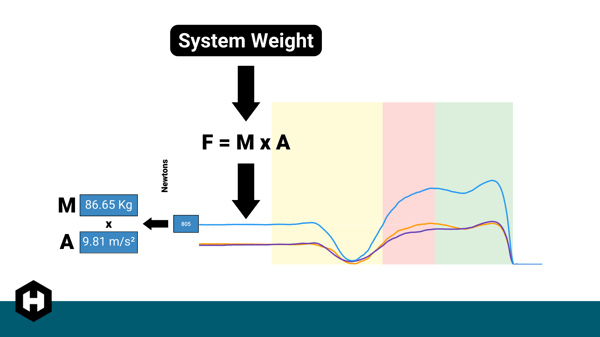
Definition: The change in system centre of mass position between the instant of take-off and peak positive vertical displacement of the system centre of mass, calculated using the vertical velocity of the system centre of mass at the instant of take-off and the equations of uniformly accelerated motion.
The vertical momentum of the system centre of mass at the instant of take-off.
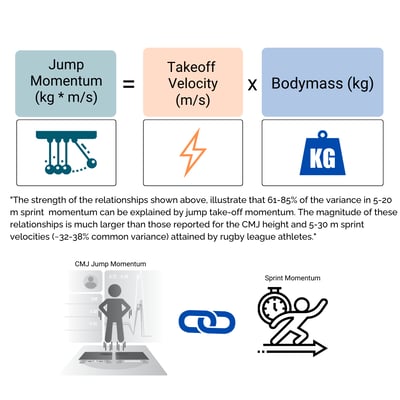
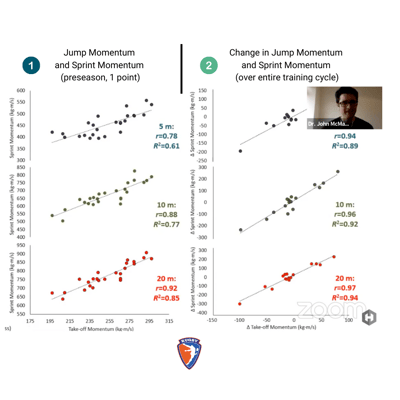
The vertical velocity of the system centre of mass at the instant of take-off.
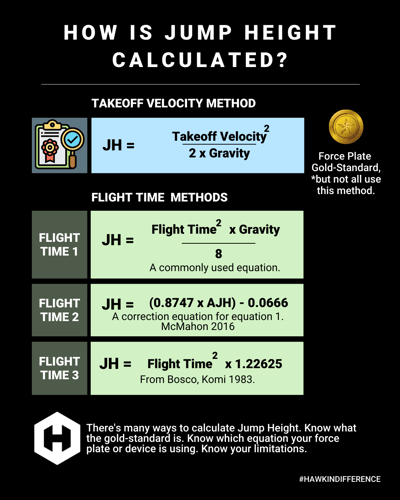
The peak instantaneous vertical velocity of the system centre of mass.
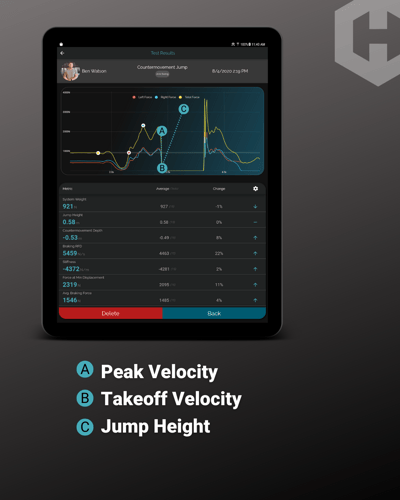
The jump height calculated using the vertical velocity of the system centre of mass at the instant of take-off divided by the total time taken from the initiation of movement to the instant of take-off (e.g. Time to Take-off).
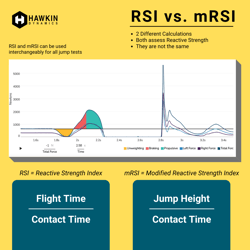
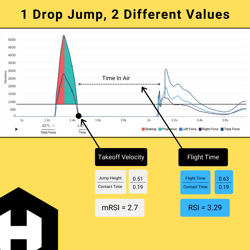
The time taken to complete the flight phase divided by the total time taken from the initiation of movement to the instant of take-off (e.g. Time to Take-off).
Historically RSI has been used more often in literature than mRSI, however with commercial force plates now more accessible, we suggest using mRSI over RSI in almost all cases.


The time taken to complete the flight phase.
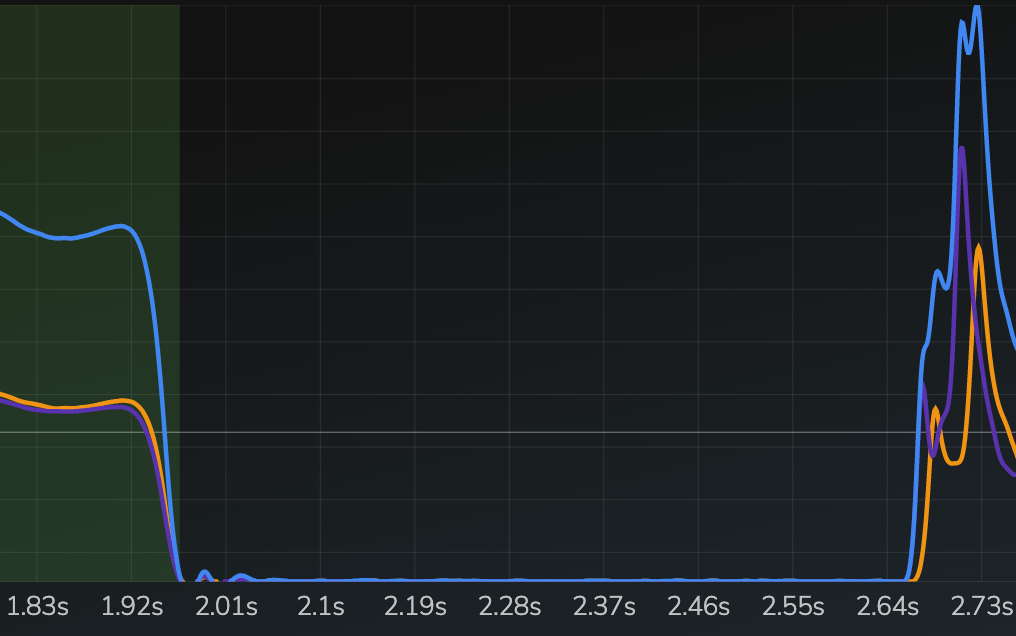
The average vertical velocity of the system centre of mass during the propulsion phase.
The peak instantaneous mechanical power applied to the system centre of mass during the propulsion phase.
The peak instantaneous mechanical power applied to the system centre of mass during the propulsion phase relative to system mass.
The average mechanical power applied to the system centre of mass during the propulsion phase.
The average mechanical power applied to the system centre of mass during the propulsion phase relative to system mass.
The peak negative instantaneous mechanical power applied to the system centre of mass during the braking phase.
The peak negative instantaneous mechanical power applied to the system centre of mass during the braking phase relative to system mass.
The average mechanical power applied to the system centre of mass during the braking phase.
The average mechanical power applied to the system centre of mass during the braking phase relative to system mass.
The average vertical velocity of the system centre of mass during the braking phase.
The peak negative instantaneous vertical velocity of the system centre of mass during the braking phase.
The total time taken from the initiation of movement to the instant of take-off.
The peak negative vertical displacement of the system centre of mass.
The ratio between the net vertical impulse applied to the system centre of mass during the propulsive phase and the net veritcal impulse applied to the system centre of mass during the braking phase of the countermovement jump. Propulsive Net Impulse / Braking Net Impulse
The time taken to complete the unweighting phase.
The time taken to complete the unweighting phase relative to the time taken to complete the movement.
The time taken to complete the braking phase.
The time taken to complete the propulsion phase.
The time taken to complete the propulsion phase relative to the time taken to complete the movement.
The vertical ground reaction force applied to the system centre of mass at the instant of peak negative vertical displacement of the system centre of mass divided by the peak negative vertical displacement of the system centre of mass during the landing phase.
The peak instantaneous vertical ground reaction force applied to the system centre of mass during the landing phase.
The average vertical ground reaction force applied to the system centre of mass during the landing phase as a percentage of system weight.
The average vertical ground reaction force applied to the system centre of mass during the landing phase.
The time taken for the vertical ground reaction force applied to the system centre of mass to remain within 5% of system weight for 1 s.
The average left vertical ground reaction force applied to the system centre of mass during the braking phase.
The average right vertical ground reaction force applied to the system centre of mass during the braking phase.
The left vertical ground reaction force applied to the system centre of mass at the point of the peak instantaneous vertical ground reaction force applied to the system centre of mass during the braking phase.
The right vertical ground reaction force applied to the system centre of mass at the point of the peak instantaneous vertical ground reaction force applied to the system centre of mass during the braking phase.
The asymmetry between the left and right average vertical ground reaction forces applied to the system centre of mass during the braking phase.
The asymmetry between the left and right vertical ground reaction forces applied to the system centre of mass at the instant of peak vertical ground reaction force during the braking phase.
The asymmetry between the left and right vertical impulses applied to the system centre of mass during the braking phase.
The average slope of the left vertical ground reaction force applied to the system centre of mass during the braking phase.
The average slope of the right vertical ground reaction force applied to the system centre of mass during the braking phase.
The asymmetry between the left and right average slope of the vertical ground reaction forces applied to the system centre of mass during the braking phase.
The average vertical ground reaction force applied to the system centre of mass during the braking phase.
The peak instantaneous vertical ground reaction force applied to the system centre of mass during the braking phase.
The average vertical ground reaction force applied to the system centre of mass during the braking phase as a percentage of system weight.
The peak instantaneous vertical ground reaction force applied to the system centre of mass during the braking phase as a percentage of system weight.
The vertical impulse applied to the system centre of mass during the braking phase relative to system mass.
The net vertical impulse applied to the system centre of mass during the braking phase relative to system mass.
The vertical impulse applied to the system centre of mass during the braking phase.
The net vertical impulse applied to the system centre of mass during the braking phase.
The average slope of the vertical ground reaction force applied to the system centre of mass during the braking phase.
The total vertical impulse applied to the system centre of mass during the braking phase and the propulsion phase.
The total vertical impulse above bodyweight applied to the system centre of mass during the braking phase and the propulsion phase.
The average left vertical ground reaction force applied to the system centre of mass during the landing phase.
The average right vertical ground reaction force applied to the system centre of mass during the landing phase.
The left vertical ground reaction force applied to the system centre of mass at the point of the peak instantaneous vertical ground reaction force applied to the system centre of mass during the landing phase.
The right vertical ground reaction force applied to the system centre of mass at the point of the peak instantaneous vertical ground reaction force applied to the system centre of mass during the landing phase.
The asymmetry between the left and right average vertical ground reaction forces applied to the system centre of mass during the landing phase.
The asymmetry between the left and right vertical ground reaction forces applied to the system centre of mass at the instant of peak vertical ground reaction force during the landing phase.
The asymmetry between the left and right vertical impulses applied to the system centre of mass during the landing phase.
The average left vertical ground reaction force applied to the system centre of mass during the propulsion phase.
The average right vertical ground reaction force applied to the system centre of mass during the propulsion phase.
The left vertical ground reaction force applied to the system centre of mass at the point of the peak instantaneous vertical ground reaction force applied to the system centre of mass during the propulsion phase.
The right vertical ground reaction force applied to the system centre of mass at the point of the peak instantaneous vertical ground reaction force applied to the system centre of mass during the propulsion phase.
The asymmetry between the left and right average vertical ground reaction forces applied to the system centre of mass during the propulsion phase.
The asymmetry between the left and right vertical ground reaction forces applied to the system centre of mass at the instant of peak vertical ground reaction force during the propulsion phase.
The asymmetry between the left and right vertical impulses applied to the system centre of mass during the propulsion phase.
The average vertical ground reaction force applied to the system centre of mass during the propulsion phase.
The peak instantaneous vertical ground reaction force applied to the system centre of mass during the propulsion phase.
The average vertical ground reaction force applied to the system centre of mass during the propulsion phase as a percentage of system weight.
The peak instantaneous vertical ground reaction force applied to the system centre of mass during the propulsion phase as a percentage of system weight.
The vertical impulse applied to the system centre of mass during the propulsion phase relative to system mass.
The net vertical impulse applied to the system centre of mass during the propulsion phase relative to system mass.
The vertical impulse applied to the system centre of mass during the propulsion phase.
The net vertical impulse applied to the system centre of mass during the propulsion phase.
The propulsive impulse is applied during the first half of the propulsive phase.
The propulsive impulse is applied during the second half of the propulsive phase.
The ratio of the propulsive impulse applied during the first half of the propulsive phase to the propulsive impulse applied during the second half of the propulsive phase.
The vertical ground reaction force applied to the system centre of mass at the instant of peak negative vertical displacement of the system centre of mass divided by the peak negative vertical displacement of the system centre of mass.
The vertical ground reaction force applied to the system centre of mass at the point of the peak negative vertical displacement of the system centre of mass.
The vertical ground reaction force applied to the system center of mass at the point of the peak negative vertical displacement of the system center of mass as a percentage of system weight.
The vertical free-fall height of the system's center of mass between the apex of the preceding jump and the instant of contact with the force plate(s) to commence the landing phase.
The duration taken to complete the landing phase, beginning at the instant of touchdown and ending when the center of mass velocity reaches zero for the first time.
A ratio that represents landing efficiency, calculated as the landing height divided by the landing time.
Squat Jump Metrics
The squat jump is an assessment of lower body active shortening (concentric, propulsion) function. It is primarily used in conjunction with the countermovement jump to calculate eccentric utilisation ratio, as well as performed under a range of external loads to calculate force-velocity profiles to identify training loads. Historically, its validity has been questioned as coaches have failed to control for athletes performing a small amplitude countermovement to initiate the movement; however, the HD software takes care of this for you! It can be performed with the arms akimbo, with an arm swing, externally loaded, and/or unilaterally.
Read about the differences between the countermovement jump and the squat jump here.
The change in system centre of mass position between the instant of take-off and peak positive vertical displacement of the system centre of mass, calculated using the vertical velocity of the system centre of mass at the instant of take-off and the equations of uniformly accelerated motion.
- Application: Output metric
- Unit(s): Meters or Inches
- Location: Flight
- Type: Displacement
- Category: Displacement
The vertical momentum of the system centre of mass at the instant of take-off.
- Unit(s): Kilogram-meter per second (Kg*m/s)
- Location: Flight
- Category: Calculation
The vertical velocity of the system centre of mass at the instant of take-off.
- Unit(s): Meters per second (m/s)
- Location: Flight
- Category: Velocity
The peak instantaneous vertical velocity of the system centre of mass.
- Unit(s): Meters per second (m/s)
- Location: Propulsive
- Category: Velocity
The total time taken from the initiation of movement to the instant of take-off.
Unit(s): Seconds (s)
Location: All
Category: Time
The time taken to complete the flight phase.
The average left vertical ground reaction force applied to the system centre of mass during the landing phase.
Unit(s): Newtons (N)
Location: Landing
Category: Force
The average right vertical ground reaction force applied to the system centre of mass during the landing phase.
Unit(s): Newtons (N)
Location: Landing
Category: Force
The asymmetry between the left and right average vertical ground reaction forces applied to the system centre of mass during the landing phase.
Unit(s): %
Location: Landing
Category: Force
The left vertical ground reaction force applied to the system centre of mass at the point of the peak instantaneous vertical ground reaction force applied to the system centre of mass during the landing phase.
Unit(s): Newtons (N)
Location: Landing
Category: Force
The right vertical ground reaction force applied to the system centre of mass at the point of the peak instantaneous vertical ground reaction force applied to the system centre of mass during the landing phase.
Unit(s): Newtons (N)
Location: Landing
Category: Force
The asymmetry between the left and right vertical ground reaction forces applied to the system centre of mass at the instant of peak vertical ground reaction force during the landing phase.
Unit(s): %
Location: Landing
Category: Force
The asymmetry between the left and right vertical impulses applied to the system centre of mass during the landing phase.
Unit(s): %
Location: Landing
Category: Impulse
The vertical ground reaction force applied to the system centre of mass at the instant of peak negative vertical displacement of the system centre of mass divided by the peak negative vertical displacement of the system centre of mass during the landing phase.
Unit(s): Newtons per meter (N/m)
Location: Landing
Category: Calculation
The average vertical ground reaction force applied to the system centre of mass during the landing phase.
Unit(s): Newtons (N)
Location: Landing
Category: Force
The peak instantaneous vertical ground reaction force applied to the system centre of mass during the landing phase.
Unit(s): Newtons (N)
Location: Landing
Category: Force
The average vertical ground reaction force applied to the system centre of mass during the landing phase as a percentage of system weight.
Unit(s): %
Location: Landing
Category: Force
The time taken for the vertical ground reaction force applied to the system centre of mass to remain within 5% of system weight for 1 s.
Unit(s): Seconds (s)
Location: Landing
Category: Time
The average left vertical ground reaction force applied to the system centre of mass during the propulsion phase.
Unit(s): Newtons (N)
Location: Propulsion
Category: Force
The average right vertical ground reaction force applied to the system centre of mass during the propulsion phase.
Unit(s): Newtons (N)
Location: Propulsion
Category: Force
The asymmetry between the left and right average vertical ground reaction forces applied to the system centre of mass during the propulsion phase.
Unit(s): %
Location: Propulsion
Category: Force
The left vertical ground reaction force applied to the system centre of mass at the point of the peak instantaneous vertical ground reaction force applied to the system centre of mass during the propulsion phase.
Unit(s): Newtons (N)
Location: Propulsion
Category: Force
The right vertical ground reaction force applied to the system centre of mass at the point of the peak instantaneous vertical ground reaction force applied to the system centre of mass during the propulsion phase.
Unit(s): Newtons (N)
Location: Propulsion
Category: Force
The asymmetry between the left and right vertical ground reaction forces applied to the system centre of mass at the instant of peak vertical ground reaction force during the propulsion phase.
Unit(s): %
Location: Propulsion
Category: Force
The asymmetry between the left and right vertical impulses applied to the system centre of mass during the propulsion phase.
Unit(s): %
Location: Propulsion
Category: Impulse
The average vertical ground reaction force applied to the system centre of mass during the propulsion phase.
Unit(s): Newtons (N)
Location: Propulsion
Category: Force
The average vertical ground reaction force applied to the system centre of mass during the propulsive phase as a percentage of system weight.
Unit(s): %
Location: Propulsion
Category: Force
The peak instantaneous vertical ground reaction force applied to the system centre of mass during the propulsion phase.
Unit(s): Newtons (N)
Location: Propulsion
Category: Force
The peak instantaneous vertical ground reaction force applied to the system centre of mass during the propulsion phase as a percentage of system weight.
Unit(s): %
Location: Propulsion
Category: Force
The vertical impulse applied to the system centre of mass during the propulsion phase relative to system mass.
Unit(s): Newton second per Kilo (N.s/Kg)
Location: Propulsion
Category: Impulse
The net vertical impulse applied to the system centre of mass during the propulsion phase relative to system mass.
Unit(s): Newton second per Kilo (N.s/Kg)
Location: Propulsion
Category: Impulse
The vertical impulse applied to the system centre of mass during the propulsion phase.
Unit(s): Newton second (N.s)
Location: Propulsion
Category: Impulse
The net vertical impulse applied to the system centre of mass during the propulsion phase.
Unit(s): Newton second (N.s)
Location: Propulsion
Category: Impulse
The propulsive impulse is applied during the first half of the propulsive phase.
Unit(s): Newton second (N.s)
Location: Propulsion
Category: Impulse
The propulsive impulse is applied during the second half of the propulsive phase.
Unit(s): Newton second (N.s)
Location: Propulsion
Category: Impulse
The ratio of the propulsive impulse applied during the first half of the propulsive phase to the propulsive impulse applied during the second half of the propulsive phase.
Unit(s): No Unit
Location: Propulsion
Category: Impulse
The average mechanical power applied to the system centre of mass during the propulsion phase relative to system mass.
Unit(s): Watts per Kilo (W/Kg)
Location: Propulsion
Category: Power
The average mechanical power applied to the system centre of mass during the propulsion phase.
Unit(s): Watts (W)
Location: Propulsion
Category: Power
The peak instantaneous mechanical power applied to the system centre of mass during the propulsion phase relative to system mass.
Unit(s): Watts per Kilo (W/Kg)
Location: Propulsion
Category: Power
The peak instantaneous mechanical power applied to the system centre of mass during the propulsion phase.
Unit(s): Watts (W)
Location: Propulsion
Category: Power
The average vertical velocity of the system centre of mass during the propulsion phase.
Unit(s): Meters per second (m/s)
Location: Propulsion
Category: Velocity
The time taken to complete the propulsion phase.
Unit(s): Seconds (s)
Location: Propulsion
Category: Time
The lowest 1 s average of the vertical ground reaction force applied to the system centre of mass during the weighting phase, identified by an optimization loop.
Unit(s): Newtons (N)
Location: Weighing
Category: Force
The vertical free-fall height of the system's center of mass between the apex of the preceding jump and the instant of contact with the force plate(s) to commence the landing phase.
The duration taken to complete the landing phase, beginning at the instant of touchdown and ending when the center of mass velocity reaches zero for the first time.
A ratio that represents landing efficiency, calculated as the landing height divided by the landing time.
Learn More
Enhance your understanding of the basics of the squat jump - a common jump assessment that reduces the contribution of the stretch-shortening cycle.
The isometric test is an assessment of maximal isometric function, also known as a technique independent measure of maximal force production. Isometric performance assessments range from whole-body (Isometric Mid-Thigh Pull, Isometric Back Squat, Isometric Belt Squat) to isolated joints (Ankle, Knee/Hip, Shoulder). The results of whole-body isometric performance assessments have been related to a multitude of dynamic athletic tasks, whereas isolated joint performance assessments have been related to injury risk. Whole-body isometric performance assessments can also be used in conjunction with the countermovement jump to calculate the dynamic strength index. Further, they can also be performed on force plates during training sessions to provide biofeedback and augment output, maximising adaptations. They are one of the most frequently used performance assessments on a force plate due to the minimal familiarization required, how rapidly they can be performed, and the wealth of information they provide. However, it must be noted that some isometric performance assessments require additional equipment.
Listen to Professor Paul Comfort Talk about isometric testing and training here
The lowest 1 s average of the vertical ground reaction force applied to the system centre of mass during the weighting phase, identified by an optimization loop.
Unit(s): Newtons (N)
Category: Force
The peak instantaneous vertical ground reaction force applied during the isometric test.
Unit(s): Newtons (N)
Category: Force
The peak instantaneous net vertical ground reaction force applied during the isometric test.
Unit(s): Newtons (N)
Category: Force
The peak instantaneous vertical ground reaction force applied during the isometric test as a percentage of system weight.
Unit(s): %
Category: Force
The asymmetry between the left and right vertical ground reaction forces applied during the isometric test at the instant of peak vertical ground reaction force.
Unit(s): %
Category: Force
The peak instantaneous left vertical ground reaction force applied during the isometric test.
Unit(s): Newtons (N)
Category: Force
The peak instantaneous right vertical ground reaction force applied during the isometric test.
Unit(s): Newtons (N)
Category: Force
The peak instantaneous vertical ground reaction force applied at 50 ms during the isometric test.
Unit(s): Newtons (N)
Category: Force
The peak instantaneous net vertical ground reaction force applied at 50 ms during the isometric test.
Unit(s): Newtons (N)
Category: Force
The peak instantaneous vertical ground reaction force applied at 50 ms during the isometric test as a percentage of system weight.
Unit(s): %
Category: Force
The peak instantaneous vertical ground reaction force applied at 50 ms during the isometric test as a percentage of last known bodyweight.
Unit(s): %
Category: Force
The peak instantaneous left vertical ground reaction force applied at 50 ms during the isometric test.
Unit(s): Newtons (N)
Category: Force
The peak instantaneous right vertical ground reaction force applied at 50 ms during the isometric test.
Unit(s): Newtons (N)
Category: Force
The average slope of the vertical ground reaction force applied during the isometric test between 0 and 50 ms.
Unit(s): Newtons per second (N/s)
Category: RFD
The vertical impulse applied during the isometric test between 0 and 50ms.
Unit(s): Newton second (N.s)
Category: Impulse
The net vertical impulse applied during the isometric test between 0 and 50ms.
Unit(s): Newton second (N.s)
Category: Impulse
The peak instantaneous vertical ground reaction force applied at 100 ms during the isometric test.
Unit(s): Newtons (N)
Category: Force
The peak instantaneous net vertical ground reaction force applied at 100 ms during the isometric test.
Unit(s): Newtons (N)
Category: Force
The peak instantaneous vertical ground reaction force applied at 100 ms during the isometric test as a percentage of system weight.
Unit(s): %
Category: Force
The peak instantaneous vertical ground reaction force applied at 100 ms during the isometric test as a percentage of last known bodyweight.
Unit(s): %
Category: Force
The peak instantaneous left vertical ground reaction force applied at 100 ms during the isometric test.
Unit(s): Newtons (N)
Category: Force
The peak instantaneous right vertical ground reaction force applied at 100 ms during the isometric test.
Unit(s): Newtons (N)
Category: Force
The average slope of the vertical ground reaction force applied during the isometric test between 0 and 100 ms.
Unit(s): Newtons per second (N/s)
Category: RFD
The vertical impulse applied during the isometric test between 0 and 100ms.
Unit(s): Newton second (N.s)
Category: Impulse
The net vertical impulse applied during the isometric test between 0 and 100 ms.
Unit(s): Newton second (N.s)
Category: Impulse
The peak instantaneous vertical ground reaction force applied at 150 ms during the isometric test.
Unit(s): Newtons (N)
Category: Force
The peak instantaneous net vertical ground reaction force applied at 150 ms during the isometric test.
Unit(s): Newtons (N)
Category: Force
The peak instantaneous vertical ground reaction force applied at 150 ms during the isometric test as a percentage of system weight.
Unit(s): %
Category: Force
The peak instantaneous vertical ground reaction force applied at 150 ms during the isometric test as a percentage of last known bodyweight.
Unit(s): %
Category: Force
The peak instantaneous left vertical ground reaction force applied at 150 ms during the isometric test.
Unit(s): Newtons (N)
Category: Force
The peak instantaneous right vertical ground reaction force applied at 150 ms during the isometric test.
Unit(s): Newtons (N)
Category: Force
The average slope of the vertical ground reaction force applied during the isometric test between 0 and 150 ms.
Unit(s): Newtons per second (N/s)
Category: RFD
The vertical impulse applied during the isometric test between 0 and 150ms.
Unit(s): Newton second (N.s)
Category: Impulse
The net vertical impulse applied during the isometric test between 0 and 150ms.
Unit(s): Newton second (N/s)
Category: Impulse
The peak instantaneous vertical ground reaction force applied at 200 ms during the isometric test.
Unit(s): Newtons (N)
Category: Force
The peak instantaneous net vertical ground reaction force applied at 200 ms during the isometric test.
Unit(s): Newtons (N)
Category: Force
The peak instantaneous vertical ground reaction force applied at 200 ms during the isometric test as a percentage of system weight.
Unit(s): %
Category: Force
The peak instantaneous vertical ground reaction force applied at 200 ms during the isometric test as a percentage of last known bodyweight.
Unit(s): %
Category: Force
The average slope of the vertical ground reaction force applied during the isometric test between 0 and 200 ms.
Unit(s): Newtons per second (N/s)
Category: RFD
The peak instantaneous left vertical ground reaction force applied at 200 ms during the isometric test.
Unit(s): Newtons (N)
Category: Force
The peak instantaneous right vertical ground reaction force applied at 200 ms during the isometric test.
Unit(s): Newtons (N)
Category: Force
The vertical impulse applied during the isometric test between 0 and 200ms.
Unit(s): Newton second (N.s)
Category: Impulse
The net vertical impulse applied during the isometric test between 0 and 200 ms.
Unit(s): Newton second (N.s)
Category: Impulse
The peak instantaneous vertical ground reaction force applied at 250 ms during the isometric test.
Unit(s): Newtons (N)
Category: Force
The peak instantaneous net vertical ground reaction force applied at 250 ms during the isometric test.
Unit(s): Newtons (N)
Category: Force
The peak instantaneous vertical ground reaction force applied at 250 ms during the isometric test as a percentage of system weight.
Unit(s): %
Category: Force
The peak instantaneous vertical ground reaction force applied at 250 ms during the isometric test as a percentage of last known bodyweight.
Unit(s): %
Category: Force
The average slope of the vertical ground reaction force applied during the isometric test between 0 and 250ms.
Unit(s): Newton per second (N/s)
Category: RFD
The peak instantaneous left vertical ground reaction force applied at 250 ms during the isometric test.
Unit(s): Newtons (N)
Category: Force
The peak instantaneous right vertical ground reaction force applied at 250 ms during the isometric test.
Unit(s): Newtons (N)
Category: Force
The vertical impulse applied during the isometric test between 0 and 250ms.
Unit(s): Newton second (N.s)
Category: Impulse
The net vertical impulse applied during the isometric test between 0 and 250 ms.
Unit(s): Newton second (N.s)
Category: Impulse
The time taken from the initiation of the pull to the return of system weight to baseline.
Unit(s): Seconds (s)
Category: Time
The time taken from the initiation of the pull to the instant of peak verical ground reaction force during the isometric test.
Unit(s): Seconds (s)
Category: Time
Drop Jump Metrics
The drop jump is an assessment of lower body fast stretch shortening cycle function, which involves the active stretching (eccentric, braking) of the lower limb musculature before it actively shortens (concentric, propulsion). The magnitude of the active stretch is dictated by the box height used, so this must be carefully considered. The drop jump is also commonly known as an assessment of reactivity. The results of this performance assessment are related to a multitude of dynamic athletic tasks, such as sprinting and deceleration. As with the countermovement jump, It is primarily used to assess changes in response to training and competition stress. It is also important to note that due to the stress imposed during a drop jump, it is also a training exercise in its own right. As such, drop jumps can be performed on the force plates during training sessions to provide biofeedback and augment output, maximising adaptations. They are one of the most frequently used performance assessments on a force plate; however, familiarisation around stepping out (not stepping down or hopping off) from the box is required. Further, to ensure it is a true fast stretch shortening cycle assessment, contact time must also be less than 250 ms. It can be performed with the arms akimbo, with an arm swing, externally loaded, and/or unilaterally.
Check out our new Drop Jump Protocol here.
Read how Dr Jason Pedley selects metrics for the drop jump here
The jump height calculated using the vertical velcity of the system centre of mass at the instant of take-off divided by the total time taken from initial contact to the instant of take-off (i.e. Time to Take-off).
Location: All
Category: Calculation
The time taken to complete the flight phase divided by the total time taken from initial contact to the instant of take-off (i.e. Time to Take-off).
Unit(s): Unitless
Location: All
Category: Calculation
The total time taken from initial contact the instant of take-off.
Unit(s): Seconds (s)
Location: All
Category: Time
The average left vertical ground reaction force applied to the system centre of mass during the braking phase.
Unit(s): Newtons (N)
Location: Braking
Category: Force
The average right vertical ground reaction force applied to the system centre of mass during the braking phase.
Unit(s): Newtons (N)
Location: Braking
Category: Force
The left vertical ground reaction force applied to the system centre of mass at the point of the peak instantaneous vertical ground reaction force applied to the system centre of mass during the braking phase.
Unit(s): Newtons (N)
Location: Braking
Category: Force
The right vertical ground reaction force applied to the system centre of mass at the point of the peak instantaneous vertical ground reaction force applied to the system centre of mass during the braking phase.
Unit(s): Newtons (N)
Location: Braking
Category: Force
The asymmetry between the left and right average vertical ground reaction forces applied to the system centre of mass during the braking phase.
Unit(s): %
Location: Braking
Category: Force
The asymmetry between the left and right vertical ground reaction forces applied to the system centre of mass at the instant of peak vertical ground reaction force during the braking phase.
Unit(s): %
Location: Braking
Category: Force
The asymmetry between the left and right vertical impulses applied to the system centre of mass during the braking phase.
Unit(s): %
Location: Braking
Category: Impulse
The average slope of the left vertical ground reaction force applied to the system centre of mass during the braking phase.
Unit(s): Newtons per second (N/s)
Location: Braking
Category: RFD
The average slope of the right vertical ground reaction force applied to the system centre of mass during the braking phase.
Unit(s): Newtons per second (N/s)
Location: Braking
Category: RFD
The asymmetry between the left and right average slope of the vertical ground reaction forces applied to the system centre of mass during the braking phase.
Unit(s): %
Location: Braking
Category: RFD
The average vertical ground reaction force applied to the system centre of mass during the braking phase.
Unit(s): Newtons (N)
Location: Braking
Category: Force
The peak instantaneous vertical ground reaction force applied to the system centre of mass during the braking phase.
Unit(s): Newtons (N)
Location: Braking
Category: Force
The average vertical ground reaction force applied to the system centre of mass during the braking phase as a percentage of system weight.
Unit(s): %
Location: Braking
Category: Force
The peak instantaneous vertical ground reaction force applied to the system centre of mass during the braking phase as a percentage of system weight.
Unit(s): %
Location: Braking
Category: Force
The vertical impulse applied to the system centre of mass during the braking phase relative to system mass.
Unit(s): Newton second per Kilo (N.s/Kg)
Location: Braking
Category: Impulse
The net vertical impulse applied to the system centre of mass during the braking phase relative to system mass.
Unit(s): Newton second per Kilo (N.s/Kg)
Location: Braking
Category: Impulse
The vertical impulse applied to the system centre of mass during the braking phase.
Unit(s): Newton second (N.s)
Location: Braking
Category: Impulse
The net vertical impulse applied to the system centre of mass during the braking phase.
Unit(s): Newton second (N.s)
Location: Braking
Category: Impulse
The average slope of the vertical ground reaction force applied to the system centre of mass during the braking phase.
Unit(s): Newton second (N.s)
Location: Braking
Category: RFD
The average mechanical power applied to the system centre of mass during the braking phase relative to system mass.
Unit(s): Watts per Kilo (W/Kg)
Location: Braking
Category: Power
The peak negative instantaneous mechanical power applied to the system centre of mass during the braking phase relative to system mass.
Unit(s): Watts per Kilo (W/Kg)
Location: Braking
Category: Power
The average mechanical power applied to the system centre of mass during the braking phase.
Unit(s): Watts (W)
Location: Braking
Category: Power
The peak negative instantaneous mechanical power applied to the system centre of mass during the braking phase.
Unit(s): Watts (W)
Location: Braking
Category: Power
The average vertical velocity of the system centre of mass during the braking phase.
Unit(s): Meters per second (m/s)
Location: Braking
Category: Velocity
An impact peak is said to have occured if the peak instantaneous vertical ground reaction force applied to the system centre of mass occurs within the first 20% of ground contact.
Unit(s): Yes/No
Location: Braking
Category: Calculation
The time taken from initial contact to the instant of the peak instantaneous vertical ground reaction force applied to the system centre of mass during the braking phase.
Unit(s): Seconds (s)
Location: Braking
Category: Time
The time taken to complete the braking phase.
Unit(s): Seconds (s)
Location: Braking
Category: Time
The time taken to complete the braking phase relative to the time taken to complete the movement.
Unit(s): %
Location: Braking
Category: Time
The total vertical impulse applied to the system centre of mass during the braking phase and the propulsion phase.
Unit(s): Newton second (N.s)
Location: Braking and Propulsion
Category: Impulse
The total vertical impulse above bodyweight applied to the system centre of mass during the braking phase and the propulsion phase.
Unit(s): Newton second (N.s)
Location: Braking and Propulsion
Category: Impulse
A Pearson product-moment correlation between the vertical ground reaction force applied to the system centre of mass and the vertical displacement of the system centre of mass.
Unit(s): Unitless
Location: Braking and Propulsion
Category: Calculation
The vertical momentum of the system centre of mass at the instant of take-off.
Unit(s): Kilogram-meter per second (Kg*m/s)
Location: Flight
Category: Calculation
The change in system centre of mass position between the instant of take-off and peak positive vertical displacement of the system centre of mass, calculated using the vertical velocity of the system centre of mass at the instant of take-off and the equations of uniformly accelerated motion.
Unit(s): Meters (m)
Location: Flight
Category: Displacement
The time taken to complete the flight phase.
Unit(s): Seconds (s)
Location: Flight
Category: Time
The vertical velocity of the system centre of mass at the instant of take-off.
Unit(s): Meters per second (m/s)
Location: Flight
Category: Velocity
The average left vertical ground reaction force applied to the system centre of mass during the landing phase.
Unit(s): Newtons (N)
Location: Landing
Category: Force
The average right vertical ground reaction force applied to the system centre of mass during the landing phase.
Unit(s): Newtons (N)
Location: Landing
Category: Force
The left vertical ground reaction force applied to the system centre of mass at the point of the peak instantaneous vertical ground reaction force applied to the system centre of mass during the landing phase.
Unit(s): Newtons (N)
Location: Landing
Category: Force
The right vertical ground reaction force applied to the system centre of mass at the point of the peak instantaneous vertical ground reaction force applied to the system centre of mass during the landing phase.
Unit(s): Newtons (N)
Location: Landing
Category: Force
The asymmetry between the left and right average vertical ground reaction forces applied to the system centre of mass during the landing phase.
Unit(s): %
Location: Landing
Category: Force
The asymmetry between the left and right vertical ground reaction forces applied to the system centre of mass at the instant of peak vertical ground reaction force during the landing phase.
Unit(s): %
Location: Landing
Category: Force
The asymmetry between the left and right vertical impulses applied to the system centre of mass during the landing phase.
Unit(s): %
Location: Landing
Category: Impulse
The vertical ground reaction force applied to the system centre of mass at the instant of peak negative vertical displacement of the system centre of mass divided by the peak negative vertical displacement of the system centre of mass during the landing phase.
Unit(s): Newtons per meter (N/m)
Location: Landing
Category: Calculation
The average vertical ground reaction force applied to the system centre of mass during the landing phase.
Unit(s): Newtons (N)
Location: Landing
Category: Force
The peak instantaneous vertical ground reaction force applied to the system centre of mass during the landing phase.
Unit(s): %
Location: Braking
Category: Time
The average vertical ground reaction force applied to the system centre of mass during the landing phase as a percentage of system weight.
Unit(s): %
Location: Landing
Category: Force
The time taken for the vertical ground reaction force applied to the system centre of mass to remain within 5% of system weight for 1 s.
Unit(s): Seconds (s)
Location: Landing
Category: Time
The vertical free fall height of the system center of mass between the instant the athlete drops off the box or platform and the instant they make contact with the force plate(s).
Unit(s): Meters (m)
Location: Preparatory
Category: Displacement
The average left vertical ground reaction force applied to the system centre of mass during the propulsion phase.
Unit(s): Newtons (N)
Location: Propulsion
Category: Force
The average right vertical ground reaction force applied to the system center of mass during the propulsion phase.
Unit(s): Newtons (N)
Location: Propulsion
Category: Force
The left vertical ground reaction force applied to the system centre of mass at the point of the peak instantaneous vertical ground reaction force applied to the system centre of mass during the propulsion phase.
Unit(s): Newtons (N)
Location: Propulsion
Category: Force
The right vertical ground reaction force applied to the system centre of mass at the point of the peak instantaneous vertical ground reaction force applied to the system centre of mass during the propulsion phase.
Unit(s): Newtons (N)
Location: Propulsion
Category: Force
The asymmetry between the left and right average vertical ground reaction forces applied to the system centre of mass during the propulsion phase.
Unit(s): %
Location: Propulsion
Category: Force
The asymmetry between the left and right vertical ground reaction forces applied to the system centre of mass at the instant of peak vertical ground reaction force during the propulsion phase.
Unit(s): %
Location: Propulsion
Category: Force
The asymmetry between the left and right vertical impulses applied to the system centre of mass during the propulsion phase.
Unit(s): %
Location: Propulsion
Category: Impulse
The average vertical ground reaction force applied to the system centre of mass during the propulsion phase.
Unit(s): Newtons (N)
Location: Propulsion
Category: Force
The peak instantaneous vertical ground reaction force applied to the system centre of mass during the propulsion phase.
Unit(s): Newtons (N)
Location: Propulsion
Category: Force
The average vertical ground reaction force applied to the system centre of mass during the propulsive phase as a percentage of system weight.
Unit(s): %
Location: Propulsion
Category: Force
The peak instantaneous vertical ground reaction force applied to the system centre of mass during the propulsion phase as a percentage of system weight.
Unit(s): %
Location: Propulsion
Category: Force
The vertical impulse applied to the system centre of mass during the propulsion phase relative to system mass.
Unit(s): Newton seconds per Kilo (N.s/Kg)
Location: Propulsion
Category: Impulse
The net vertical impulse applied to the system centre of mass during the propulsion phase relative to system mass.
Unit(s): Newton seconds per Kilo (N.s/Kg)
Location: Propulsion
Category: Impulse
The vertical impulse applied to the system centre of mass during the propulsion phase.
Unit(s): Newton seconds (N.s)
Location: Propulsion
Category: Impulse
The net vertical impulse applied to the system centre of mass during the propulsion phase.
Unit(s): Newton seconds (N.s)
Location: Propulsion
Category: Impulse
The average mechanical power applied to the system centre of mass during the propulsion phase relative to system mass.
Unit(s): Watts per Kilo (W/Kg)
Location: Propulsion
Category: Power
The peak instantaneous mechanical power applied to the system centre of mass during the propulsion phase relative to system mass.
Unit(s): Watts per Kilo (W/Kg)
Location: Propulsion
Category: Power
The average mechanical power applied to the system centre of mass during the propulsion phase.
Unit(s): Watts (W)
Location: Propulsion
Category: Power
The peak instantaneous mechanical power applied to the system centre of mass during the propulsion phase.
Unit(s): Watts (W)
Location: Propulsion
Category: Power
The average vertical velocity of the system centre of mass during the propulsion phase.
Unit(s): Meters per second (m/s)
Location: Propulsion
Category: Velocity
The peak instantaneous vertical velocity of the system centre of mass.
Unit(s): Meters per second (m/s)
Location: Propulsion
Category: Velocity
The time taken to complete the propulsion phase.
Unit(s): Seconds (s)
Location: Propulsion
Category: Time
The time taken to complete the propulsion phase relative to the time taken to complete the movement.
Unit(s): %
Location: Propulsion
Category: Time
The vertical ground reaction force applied to the system centre of mass at the instant of peak negative vertical displacement of the system centre of mass divided by the peak negative vertical displacement of the system centre of mass.
Unit(s): Newtons per meter (N/m)
Location: Transfer
Category: Calculation
The vertical ground reaction force applied to the system centre of mass at the point of the peak negative vertical displacement of the system centre of mass.
Unit(s): Newtons (N)
Location: Transfer
Category: Force
The vertical ground reaction force applied to the system centre of mass at the point of the peak negative vertical displacement of the system centre of mass as a percentage of system weight.
Unit(s): %
Location: Transfer
Category: Force
The peak negative vertical displacement of the system centre of mass.
Unit(s): Meters (m)
Location: Transfer
Category: Displacement
The ratio between the net vertical impulse applied to the system centre of mass during the braking phase and the net veritcal impulse applied to the system centre of mass during the propulsion phase.
Unit(s): Unitless
Location: Transfer
Category: Impulse
The lowest 1 s average of the vertical ground reaction force applied to the system centre of mass during the weighting phase, identified by an optimization loop.
Unit(s): Newtons (N)
Location: Weighing
Category: Force
The vertical free fall height of the system center of mass between apex of the preceding jump and the instant they make contact with the force plate(s) to commence the landing phase.
Unit(s): Newtons (N)
Location: Landing
Category: Displacement
The landing height divided by the landing time.
Unit(s): No Unit
Location: Landing
Category: Ratio
The time taken to complete the landing phase (starting at the instant of touchdown and ending at the first instant that center of mass velocity equals zero).
Unit(s): Seconds (s)
Location: Landing
Category: Time
The user inputted box height.
Unit(s): Meters (m)
Location: Preparatory
Category: Displacement
Learn More
Enhance your understanding of the basics of the drop jump - a common assessment of reactive strength and rebound ability..
Countermovement Rebound Jump Metrics
The countermovement rebound jump is a multifaceted performance assessment. The countermovement jump phase is an assessment of lower body slow stretch shortening cycle function, whereas the rebound jump phase is an assessment of lower body fast stretch shortening cycle function. The magnitude of the active stretch during the rebound phase is dictated by the jump height of the countermovement jump phase. There is limited research available on the countermovement rebound jump performance assessment; however, essentially it is the combination of the countermovement jump and the drop jump, so it provides the same information in less time - why perform two performance assessments when you can perform one? It is rapidly becoming a popular performance assessment due to the wealth of information it provides and the time it saves; however, familiarisation to ensure the countermovement jump is maximal and the rebound jump is less than 250 ms is required. It can be performed with the arms akimbo, with an arm swing, externally loaded, and/or unilaterally.
The jump height calculated using the vertical velcity of the system centre of mass at the instant of take-off divided by the total time taken from the initiation of movement to the instant of take-off (i.e. Time to Take-off) during the countermovement jump.
The time taken to complete the flight phase divided by the total time taken from the initiation of movement to the instant of take-off (i.e. Time to Take-off) during the countermovement jump.
The total time taken from the initiation of movement to the instant of take-off of the countermovement jump.
The jump height of the rebound calculated using the vertical velcity of the system centre of mass at the instant of take-off divided by the total time taken from initial contact to the instant of take-off (i.e. Time to Take-off) of the rebound.
The time taken to complete the flight phase of the rebound divided by the total time taken from initial contact to the instant of take-off (i.e. Time to Take-off) of the rebound.
The total time taken from initial contact the instant of take-off of the rebound.
The average left vertical ground reaction force applied to the system centre of mass during the braking phase of the countermovement jump.
The average right vertical ground reaction force applied to the system centre of mass during the braking phase of the countermovement jump.
The asymmetry between the left and right average vertical ground reaction forces applied to the system centre of mass during the braking phase of the countermovement jump.
The asymmetry between the left and right vertical impulses applied to the system centre of mass during the braking phase of the countermovement jump.
The average vertical ground reaction force applied to the system centre of mass during the braking phase of the countermovement jump.
The peak instantaneous vertical ground reaction force applied to the system centre of mass during the braking phase of the countermovement jump.
The average vertical ground reaction force applied to the system centre of mass during the braking phase of the countermovement jump as a percentage of system weight.
The peak instantaneous vertical ground reaction force applied to the system centre of mass during the braking phase of the countermovement jump as a percentage of system weight.
The vertical impulse applied to the system centre of mass during the braking phase of the countermovement jump relative to system mass.
The net vertical impulse applied to the system centre of mass during the braking phase of the countermovement jump relative to system mass.
The vertical impulse applied to the system centre of mass during the braking phase of the countermovement jump.
The net vertical impulse applied to the system centre of mass during the braking phase of the countermovement jump.
The average slope of the vertical ground reaction force applied to the system centre of mass during the braking phase of the countermovement jump.
The average mechanical power applied to the system centre of mass during the braking phase of the countermovement jump relative to system mass.
The peak negative instantaneous mechanical power applied to the system centre of mass during the braking phase of the countermovement jump relative to system mass.
The average mechanical power applied to the system centre of mass during the braking phase of the countermovement jump.
The peak negative instantaneous mechanical power applied to the system centre of mass during the braking phase of the countermovement jump.
The average left vertical ground reaction force applied to the system centre of mass during the braking phase of the rebound.
The average right vertical ground reaction force applied to the system centre of mass during the braking phase of the rebound.
The asymmetry between the left and right average vertical ground reaction forces applied to the system centre of mass during the braking phase of the rebound.
The asymmetry between the left and right vertical impulses applied to the system centre of mass during the braking phase of the rebound.
The average vertical ground reaction force applied to the system centre of mass during the braking phase of the rebound.
The peak instantaneous vertical ground reaction force applied to the system centre of mass during the braking phase of the rebound.
The average vertical ground reaction force applied to the system centre of mass during the braking phase of the rebound as a percentage of system weight.
The peak instantaneous vertical ground reaction force applied to the system centre of mass during the braking phase of the rebound as a percentage of system weight.
The vertical impulse applied to the system centre of mass during the braking phase of the rebound relative to system mass.
The net vertical impulse applied to the system centre of mass during the braking phase of the rebound relative to system mass.
The vertical impulse applied to the system centre of mass during the braking phase of the rebound.
The net vertical impulse applied to the system centre of mass during the braking phase of the rebound.
The average mechanical power applied to the system centre of mass during the braking phase of the rebound relative to system mass.
The peak negative instantaneous mechanical power applied to the system centre of mass during the braking phase of the rebound relative to system mass.
The average mechanical power applied to the system centre of mass during the braking phase of the rebound.
The peak negative instantaneous mechanical power applied to the system centre of mass during the braking phase of the rebound.
An impact peak is said to have occured if the peak instantaneous vertical ground reaction force applied to the system centre of mass occurs within the first 20% of ground contact of the rebound.
The time taken from initial contact to the instant of the peak instantaneous vertical ground reaction force applied to the system centre of mass during the braking phase of the rebound.
The total vertical impulse applied to the system centre of mass during the braking phase and the propulsion phase of the countermovement jump.
The total vertical impulse above bodyweight applied to the system centre of mass during the braking phase and the propulsion phase of the countermovement jump.
The total vertical impulse applied to the system centre of mass during the braking phase and the propulsion phase of the rebound.
The total vertical impulse above bodyweight applied to the system centre of mass during the braking phase and the propulsion phase of the rebound.
A Pearson product-moment correlation between the vertical ground reaction force applied to the system centre of mass and the vertical displacement of the system centre of mass of the rebound.
The vertical momentum of the system centre of mass at the instant of take-off during the countermovement jump.
The change in system centre of mass position between the instant of take-off and peak positive vertical displacement of the system centre of mass during the countermovement jump, calculated using the vertical velocity of the system centre of mass at the instant of take-off and the equations of uniformly accelerated motion.
The vertical momentum of the system centre of mass at the instant of take-off of the rebound.
The change in system centre of mass position between the instant of take-off and peak positive vertical displacement of the system centre of mass during the rebound, calculated using the vertical velocity of the system centre of mass at the instant of take-off and the equations of uniformly accelerated motion.
The time taken to complete the flight phase of the rebound.
The vertical ground reaction force applied to the system centre of mass at the instant of peak negative vertical displacement of the system centre of mass divided by the peak negative vertical displacement of the system centre of mass during the landing phase.
The average vertical ground reaction force applied to the system centre of mass during the landing phase.
The peak instantaneous vertical ground reaction force applied to the system centre of mass during the landing phase.
The average vertical ground reaction force applied to the system centre of mass during the landing phase as a percentage of system weight.
The time taken for the vertical ground reaction force applied to the system centre of mass to remain within 5% of system weight for 1 s.
The average left vertical ground reaction force applied to the system centre of mass during the landing phase.
The average right vertical ground reaction force applied to the system centre of mass during the landing phase.
The left vertical ground reaction force applied to the system centre of mass at the point of the peak instantaneous vertical ground reaction force applied to the system centre of mass during the landing phase.
The right vertical ground reaction force applied to the system centre of mass at the point of the peak instantaneous vertical ground reaction force applied to the system centre of mass during the landing phase.
The asymmetry between the left and right average vertical ground reaction forces applied to the system centre of mass during the landing phase.
The asymmetry between the left and right vertical ground reaction forces applied to the system centre of mass at the instant of peak vertical ground reaction force during the landing phase.
The asymmetry between the left and right vertical impulses applied to the system centre of mass during the landing phase.
The average left vertical ground reaction force applied to the system centre of mass during the propulsion phase of the countermovement jump.
The average right vertical ground reaction force applied to the system centre of mass during the propulsion phase of the countermovement jump.
The asymmetry between the left and right average vertical ground reaction forces applied to the system centre of mass during the propulsion phase of the countermovement jump.
The asymmetry between the left and right vertical impulses applied to the system centre of mass during the propulsion phase of the countermovement jump.
The average vertical ground reaction force applied to the system centre of mass during the propulsion phase of the countermovement jump.
The peak instantaneous vertical ground reaction force applied to the system centre of mass during the propulsion phase of the countermovement jump.
The average vertical ground reaction force applied to the system centre of mass during the propulsion phase of the countermovement jump as a percentage of system weight.
The peak instantaneous vertical ground reaction force applied to the system centre of mass during the propulsion phase of the countermovement jump as a percentage of system weight.
The vertical impulse applied to the system centre of mass during the propulsion phase of the countermovement jump relative to system mass.
The net vertical impulse applied to the system centre of mass during the propulsion phase of the countermovement jump relative to system mass.
The vertical impulse applied to the system centre of mass during the propulsion phase of the countermovement jump.
The net vertical impulse applied to the system centre of mass during the propulsion phase of the countermovement jump.
The propulsive impulse is applied during the first half of the propulsive phase.
The propulsive impulse is applied during the second half of the propulsive phase.
The ratio of the propulsive impulse applied during the first half of the propulsive phase to the propulsive impulse applied during the second half of the propulsive phase.
The average mechanical power applied to the system centre of mass during the propulsion phase of the countermovement jump relative to system mass.
The peak instantaneous mechanical power applied to the system centre of mass during the propulsion of the countermovement jump phase relative to system mass.
The average mechanical power applied to the system centre of mass during the propulsion phase of the countermovement jump.
The peak instantaneous mechanical power applied to the system centre of mass during the propulsion phase of the countermovement jump.
The average left vertical ground reaction force applied to the system centre of mass during the propulsion phase of the rebound.
The average right vertical ground reaction force applied to the system centre of mass during the propulsion phase of the rebound.
The asymmetry between the left and right average vertical ground reaction forces applied to the system centre of mass during the propulsion phase of the rebound.
The asymmetry between the left and right vertical impulses applied to the system centre of mass during the propulsion phase of the rebound.
The average vertical ground reaction force applied to the system centre of mass during the propulsion phase of the rebound.
The peak instantaneous vertical ground reaction force applied to the system centre of mass during the propulsion phase of the rebound.
The average vertical ground reaction force applied to the system centre of mass during the propulsive phase of the rebound as a percentage of system weight.
The peak instantaneous vertical ground reaction force applied to the system centre of mass during the propulsion phase of the rebound as a percentage of system weight.
The vertical impulse applied to the system centre of mass during the propulsion phase of the rebound relative to system mass.
The net vertical impulse applied to the system centre of mass during the propulsion phase of the rebound relative to system mass.
The vertical impulse applied to the system centre of mass during the propulsion phase of the rebound.
The net vertical impulse applied to the system centre of mass during the propulsion phase of the rebound.
The propulsive impulse is applied during the first half of the propulsive phase.
The propulsive impulse is applied during the second half of the propulsive phase.
The ratio of the propulsive impulse applied during the first half of the propulsive phase to the propulsive impulse applied during the second half of the propulsive phase.
The average mechanical power applied to the system centre of mass during the propulsion phase of the rebound relative to system mass.
The peak instantaneous mechanical power applied to the system centre of mass during the propulsion phase of the rebound relative to system mass.
The average mechanical power applied to the system centre of mass during the propulsion phase of the rebound.
The peak instantaneous mechanical power applied to the system centre of mass during the propulsion phase of the rebound.
The vertical ground reaction force applied to the system centre of mass at the point of the peak negative vertical displacement of the system centre of mass during the countermovement jump.
The vertical ground reaction force applied to the system centre of mass at the point of the peak negative vertical displacement of the system centre of mass as a percentage of system weight.
The peak negative vertical displacement of the system centre of mass of the of the countermovement jump.
The ratio between the net vertical impulse applied to the system centre of mass during the braking phase and the net veritcal impulse applied to the system centre of mass during the propulsion phase of the countermovement jump.
The vertical ground reaction force applied to the system centre of mass at the instant of peak negative vertical displacement of the system centre of mass divided by the peak negative vertical displacement of the system centre of mass during the rebound.
The vertical ground reaction force applied to the system centre of mass at the point of the peak negative vertical displacement of the system centre of mass during the rebound.
The vertical ground reaction force applied to the system centre of mass at the point of the peak negative vertical displacement of the system centre of mass during the rebound as a percentage of system weight.
The peak negative vertical displacement of the system centre of mass during the rebound.
The ratio between the net vertical impulse applied to the system centre of mass during the braking phase and the net veritcal impulse applied to the system centre of mass during the propulsion phase of the rebound.
The lowest 1 s average of the vertical ground reaction force applied to the system centre of mass during the weighting phase, identified by an optimization loop.
The vertical free-fall height of the system's center of mass between the apex of the preceding jump and the instant of contact with the force plate(s) to commence the landing phase.
The duration taken to complete the landing phase, beginning at the instant of touchdown and ending when the center of mass velocity reaches zero for the first time.
A ratio that represents landing efficiency, calculated as the landing height divided by the landing time.
Learn More
Enhance your understanding of the basics of the CMJ Rebound - a useful dynamic movement for evaluating an athlete’s reactivity and overall jump ability.
The average contact time (the total time taken from initial contact to the instant of take-off) of the repetitions in which the three highest jumps were achieved during the multi-rebound test.
The average contact time (the total time taken from initial contact to the instant of take-off) of the repetitions in which the five highest jumps were achieved during the multi-rebound test.
The average contact time (the total time taken from initial contact to the instant of take-off) of all repetitions completed during the multi-rebound test.
Learn More
Enhance your understanding of the basics of the Mulit-Rebound Jump - a useful dynamic movement for evaluating an athlete's reactivity and fatigue levels.
Free Run Metrics (and Center of Pressure)
Description: The total distance of anterior-posterior sway on the left plate during the free run.
Unit(s): cm
Category: COP
The amplitude of anterior-posterior sway on the left plate during the free run.
Unit(s): cm
Category: COP
The average anterior-posterior sway velocity on the left plate during the free run.
Unit(s): cm/s
Category: COP
The average medial-lateral sway velocity on the left plate during the free run.
Unit(s): cm/s
Category: COP
The total distance of medial-lateral sway on the left plate during the free run.
Unit(s): cm
Category: COP
The amplitude of medial-lateral sway on the left plate during the free run.
Unit(s): cm
Category: COP
The total distance of sway on the left plate during the free run.
Unit(s): cm
Category: COP
The amplitude of sway on the left plate during the free run.
Unit(s): cm
Category: COP
The average sway velocity on the left plate during the free run.
Unit(s): cm/s
Category: COP
The total distance of anterior-posterior sway on the right plate during the free run.
Unit(s): cm
Category: COP
The amplitude of anterior-posterior sway on the right plate during the free run.
Unit(s): cm
Category: COP
The average anterior-posterior sway velocity on the right plate during the free run.
Unit(s): cm/s
Category: COP
The average medial-lateral sway velocity on the right plate during the free run.
Unit(s): cm/s
Category: COP
The total distance of medial-lateral sway on the right plate during the free run.
Unit(s): cm
Category: COP
The amplitude of medial-lateral sway on the right plate during the free run.
Unit(s): cm
Category: COP
The total distance of sway on the right plate during the free run.
Unit(s): cm
Category: COP
The amplitude of sway on the right plate during the free run.
Unit(s): cm
Category: COP
The average sway velocity on the right plate during the free run.
Unit(s): cm/s
Category: COP
Weigh-In Metrics
The weigh-in test is a simple assessment of bodyweight (and stability). The test eliminates the need for purchasing a separate scale, and reports in Newtons, Kilograms, and Pounds. Change the weigh-in duration under test settings on the tablet, we suggest weighing for at least 5-seconds.

Body weight measured in Newtons
Body weight measured in Kilograms
Body weight measured in Pounds
The standard deviation of the body weight during the weigh-in
-2.png?width=200&height=77&name=Hawkin%20Logo%20(2)-2.png)
-1.png?width=155&height=60&name=WHITE.Horizontal_Logo.Transparent%20(3)-1.png)

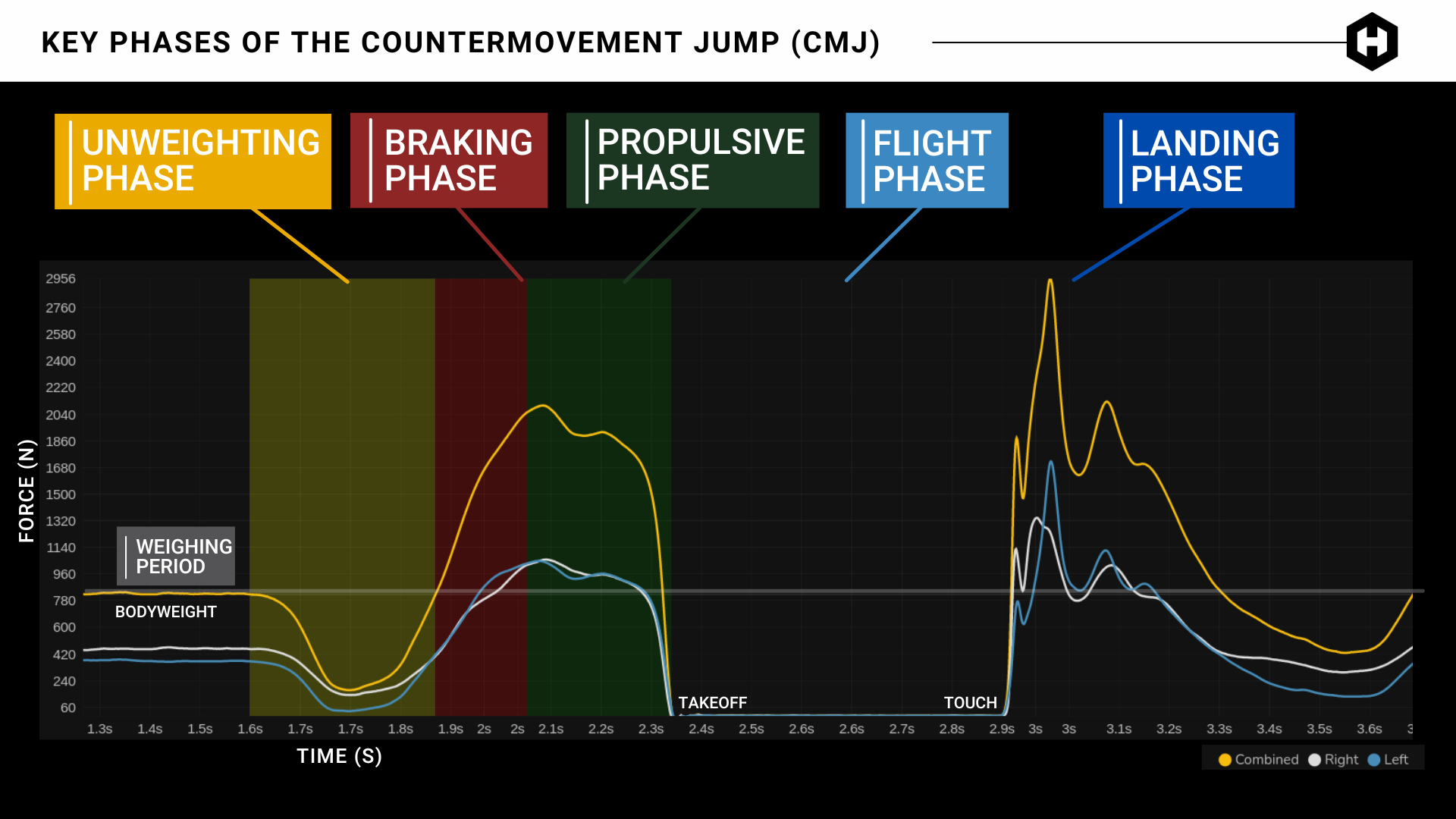

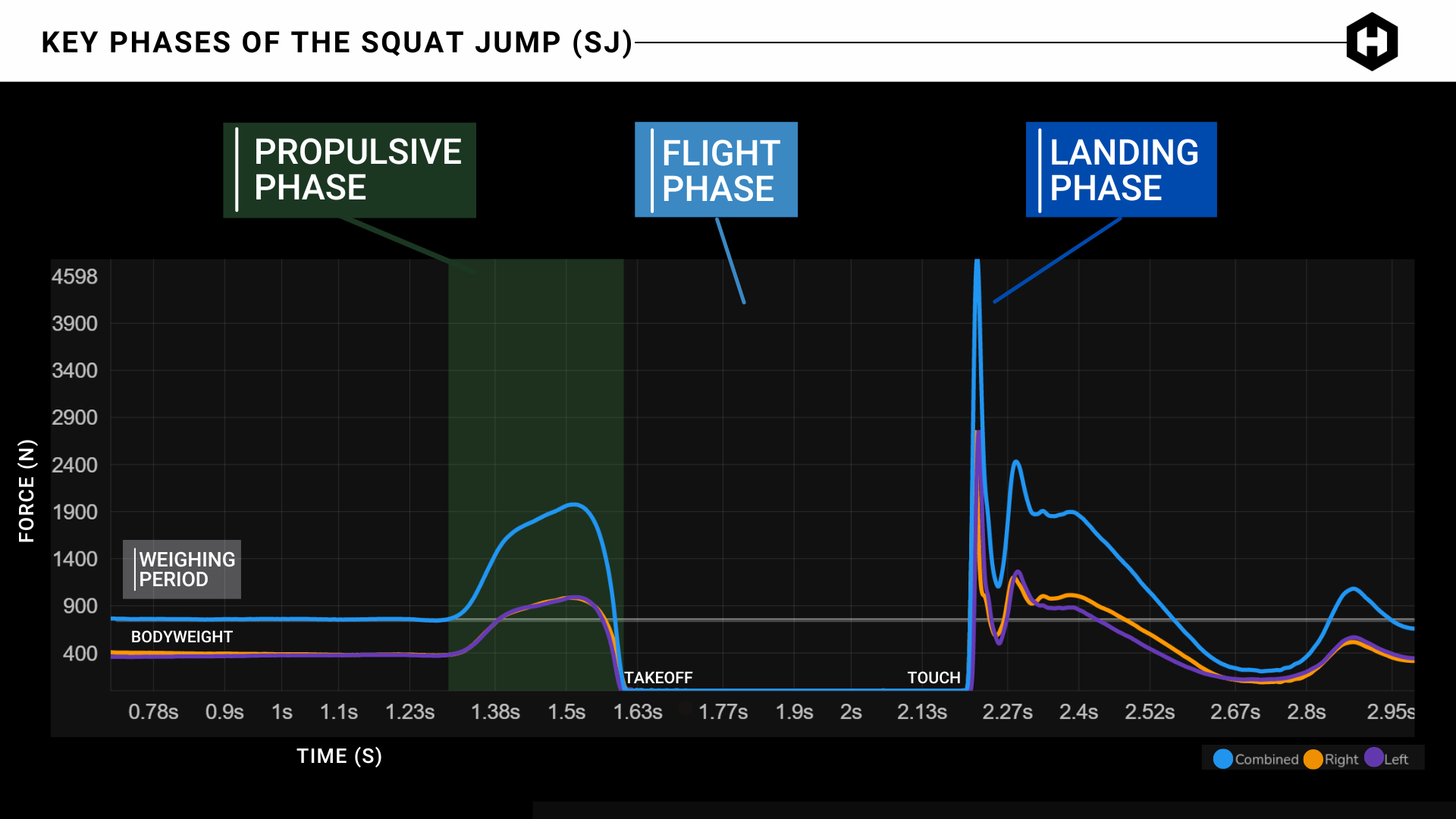

.png)
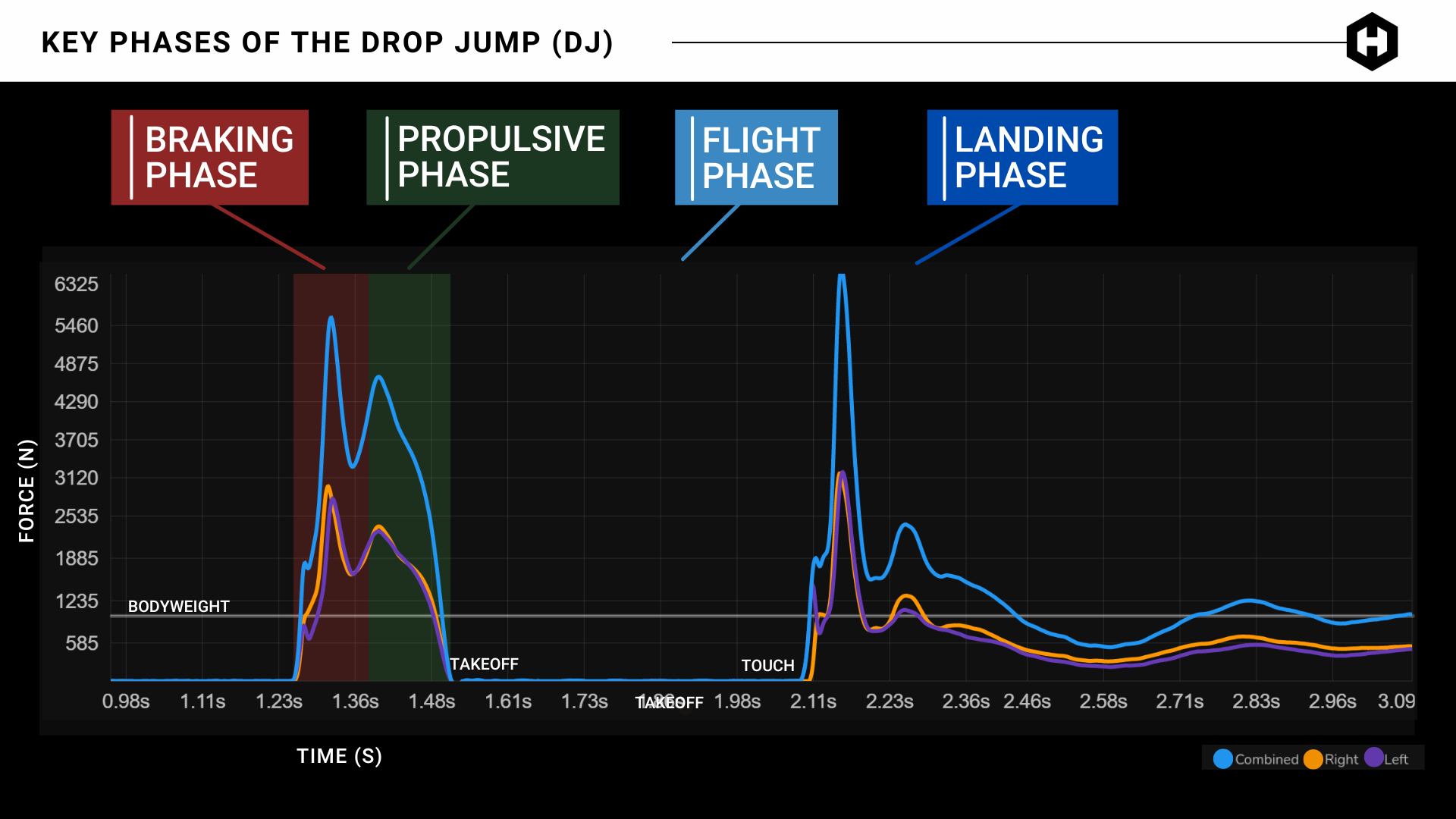

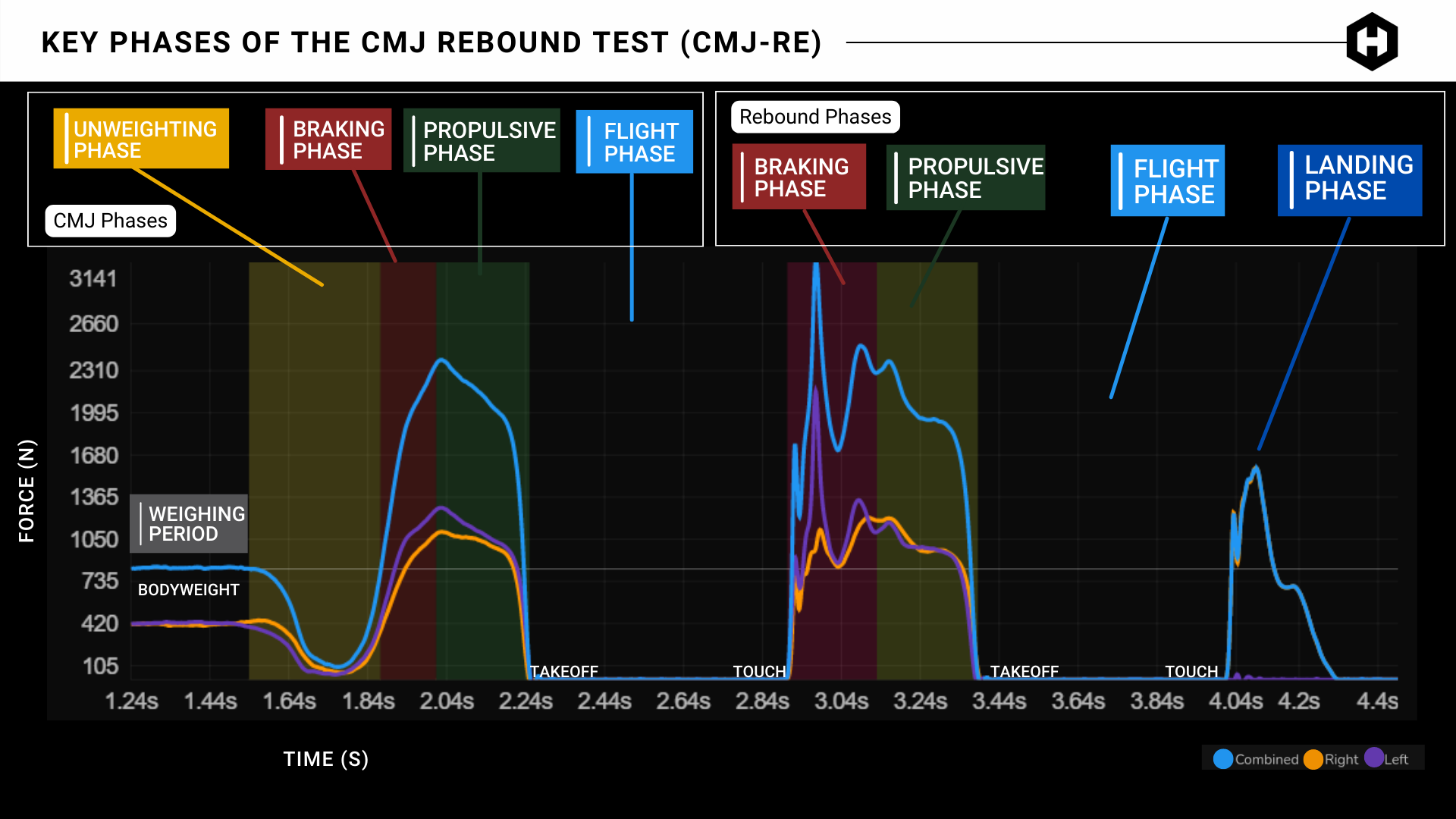

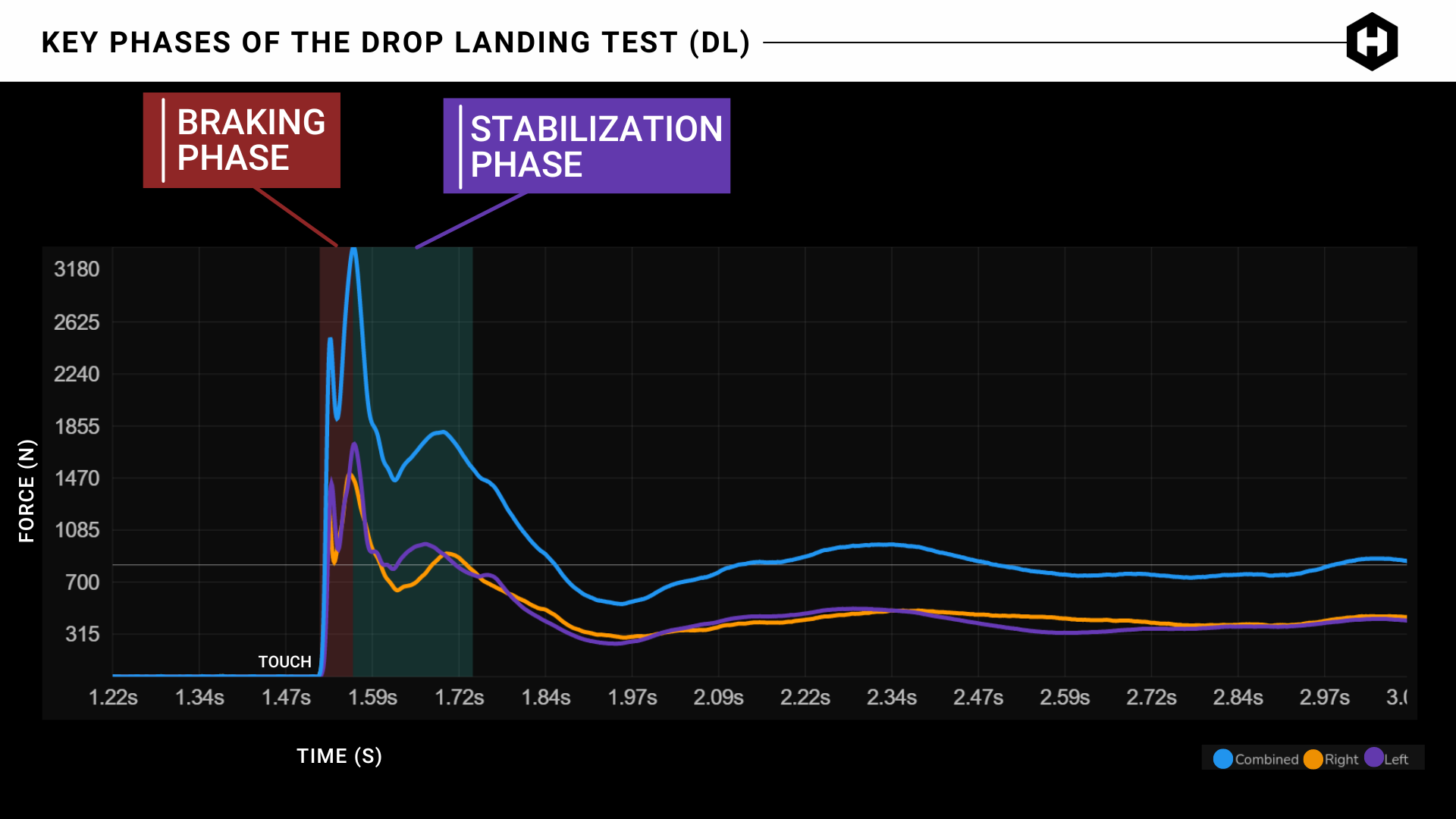
.png)
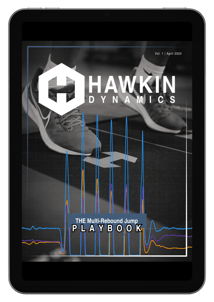
.png)

